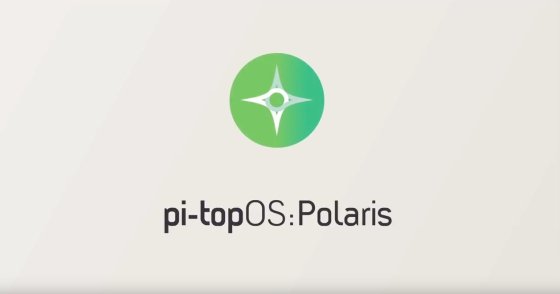Brian McEvoy wanted to create a musical instrument that could withstand a lot of physical punishment and abuse. So, he designed a piano called the Tough Pi-ano, which could be played using arcade buttons. Each octave of the piano has a Raspberry Pi Zero beneath it which are used to produce the tones. You can read a lot more about the project over on his blog and see a demo video below:
New version of pi-topOS released for the Raspberry Pi – try it out today!
pi-top have just announced a new version of their pi-topOS operating system. The new version, called Polaris, has a fresh new dashboard design and updates to the CODER programming interface. pi-topOS offers a lot of user interface improvements over the standard Raspbian OS and is well worth trying out. Myself and the other pi-topCHAMPIONS got a chance to beta-test the new OS on our recent away-weekend at Bletchley Park. It really is a step-change for pi-top and they’ve clearly worked hard to be the number one choice of OS for the Raspberry Pi. So, if you’ve never tried it before, give it a go. And if you’ve used pi-topOS before, now’s a good time to download the image and try out the improvements. See the launch video below:
Enormous art installation in Boston uses a Raspberry Pi to control a block of blinkies
In Boston’s Rose Kennedy Greenway, twenty-four sentinels have appeared in a 2001-kind of way. They are called Light Blades and overlook the parks of the Wharf District. The lights inside the blades react to text messages sent to a specific number and it’s apparently quite a sight – a space the size of a city block changing colour to your request. This is a public art installation called Color Commons and it is the brainchild of New American Public Art (NAPA), a collection of six artists.
The system works by using an SMS server which communicates to a Raspberry Pi at the park. The Pi matches the name of the colour to a list of 950 known colours and then sends commands to the Light Blades. The reaction time of the system is roughly two seconds, which is impressive considering the round-trip the messages make.
Dan Sternof Beyer, one of the creative directors of NAPA said this of the project:
“The art side of it is really thinking about the sociology of the public and thinking about what draws people in, what makes them curious, and what brings out curiosity,”
Read more about the project here, see the code for the project here and see a video of it in action below:
This Fallout 4 terminal has a Raspberry Pi inside
The folks over at Power Up Props have 3D printed and painted this lovely Fallout 4-style terminal and given it a Raspberry Pi heart. It’s more a 3D printing project than a Raspberry Pi project, but it’s always nice to see the Pi in unusual places! Now all they need to do is create the UI shown in Fallout to complete the picture. See more pictures on Imgur.
YouTube player uses an old Casio TV 880 and a Raspberry Pi Zero
David Watts had an old Casio TV 880 unit and he wondered if he could use it as a display for a Raspberry Pi. The Casio has a composite input which can be used, and handily the Pi has a composite output. Fusing the two together with an A+ to start with, David soon realised that a Zero would fit perfectly in a void in the casing. You can see a video of the disassembly and A+ try-out below:
Picademy USA expands with four venues and eight dates for future Raspberry Pi Certified Educators

![]() The Raspberry Pi Foundation has announced that they are to run more free Picademies for educators in the USA this Spring. The eight courses will be run in Rhode Island, California, Michigan and Idaho, two days per course, and at the end the participants can be proud to call themselves Raspberry Pi Certified Educators. The dates/venues are as follows:
The Raspberry Pi Foundation has announced that they are to run more free Picademies for educators in the USA this Spring. The eight courses will be run in Rhode Island, California, Michigan and Idaho, two days per course, and at the end the participants can be proud to call themselves Raspberry Pi Certified Educators. The dates/venues are as follows:
| CITY | VENUE | DATES | APPLY BY |
|---|---|---|---|
| Providence, RI | Johnson & Wales University | June 5 – 6 | April 13 |
| Providence, RI | Johnson & Wales University | June 8 – 9 | April 13 |
| Irvine, CA | University of California, Irvine | June 19 – 20 | April 27 |
| Irvine, CA | University of California, Irvine | June 22 – 23 | April 27 |
| Ann Arbor, MI | Ann Arbor District Library | July 24 – 25 | June 2 |
| Ann Arbor, MI | Ann Arbor District Library | July 27 – 28 | June 2 |
| Boise, ID | JUMP | August 7 – 8 | June 16 |
| Boise, ID | JUMP | August 10 – 11 | June 16 |
More details about the courses and how to apply can be found on the Foundation’s website.






